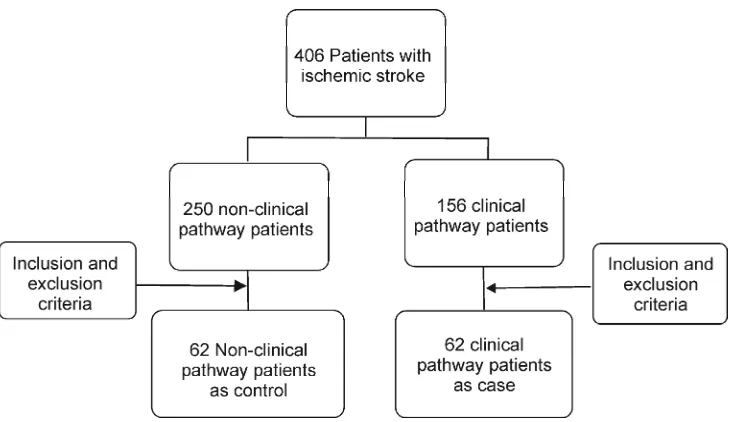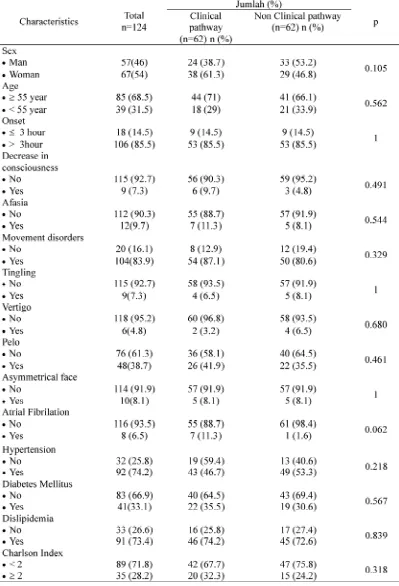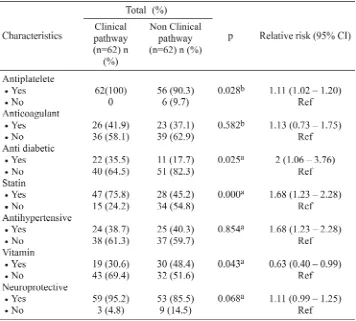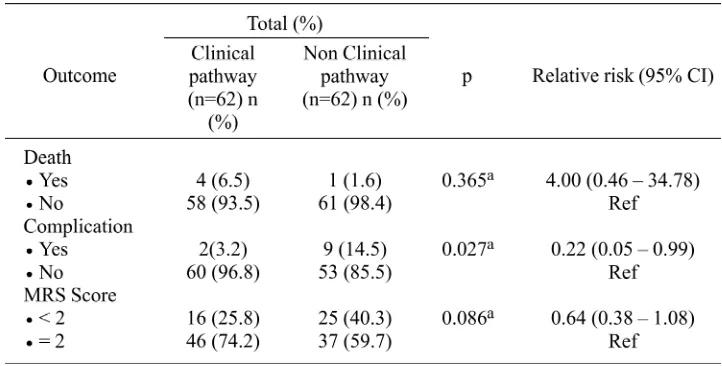* corresponding author: indrihardani@yahoo.com
The role of clinical pathway on the
outcomes of ischemic stroke patients at
Bethesda Hospital Yogyakarta
Francisca Diana A1*, Iwan Dwiprahasto2, Rizaldy Pinzon3
1Department of Pharmacology and Theraphy, Faculty of Medicine, Universitas Palangkaraya,
Central Kalimantan, 2Department of Pharmacology and Therapy, Faculty of Medicine,
Universitas Gadjah Mada, Yogyakarta,3Department of Neurology, Bethesda Hospital,
Yogyakarta, Indonesia
ABSTRACT
Stroke becomes world health problem all over the world because it is the causal factor of high mortality and disability. Good and well-organized process of healthcare service will improve the outcome of the patients with stroke. Clinical pathway may be used as clear standard to help reduce unnecessary variations of medical treatment and measure. The study aimed at finding out the correlation between the use of clinical pathway and the outcome of the patients with ischemic stroke in Bethesda Hospital Yogyakarta. It was an observational and analytic study with cohort restorative study design. The author compared the outcomes of acute ischemic stroke between the group with clinical pathway and the group without the clinical pathway. Data was collected using consecutive sampling from the electronic registry and medical record data of the patients from January 1st, 2011
to December 31st, 2011. It was conducted to 124 patients with ischemic stroke assigned to two
groups (the first groups of 62 patients with clinical pathway and the second groups of 62 patients without clinical pathway). The basic characteristics of the two groups were the same. The results of the analysis showed that there was a significant decrease in the incidence of complication and a significant increase in the use of antiplatelete drugs, antidiabetic drugs and statin as secondary preventive measure of the recurrent stroke. There was not any significant difference in the duration of the hospitalized healthcare, the financing and the mortality between the two observation groups. In conclusion, the study indicated that the use of the clinical pathway in the stroke treatment improves the outcome of the patients with stroke and that it is necessary to conduct further study to evaluate the effectiveness of the clinical pathway in improving the outcome of the patients with bigger number of the subjects and longer period of time.
ABSTRAK
rawat inap, pembiayaan dan kematian diantara dua kelompok pengamatan. Penelitian ini menunjukkan bahwa pemberlakuanclinical pathway pada pelayan stroke memperbaiki luaran pasien stroke. Penelitian lebih lanjut sangat diperlukan untuk menilai efektivitasclinical pathway
terhadap luaran pasien dengan jumlah subyek yang lebih banyak dan jangka waktu yang lebih lama.
Keywords:clinical pathway - stroke - outcomes
INTRODUCTION
Stroke becomes main health problem all over the world because it is the causal factor of high mortality and disability. In Indonesia, it ranks the highest in causing death, followed by diabetes mellitus and hypertension in both rural and urban areas.1 Good and well-organized
healthcare service process such as the one in the stroke unit will improve the outcome of the patients with stroke because it decreases mortality risk in a year.2 It is possible that
multidisciplinary healthcare service in the stroke unit result in various medical measures prone to malpractices.
Clinical pathway may be used as clear standard to help reduce unnecessary variations. The clinical pathway or care pathway or critical pathway is a healthcare service planning concept that aims at improving the efficiency of the healthcare service organization for the patients with stroke in which the healthcare service is delivered in multidisciplinary manner on scientific evidence with medical care standard.3,4
The clinical pathway to handle the patients with stroke in Bethesda Hospital, Yogyakarta has been introduced since the beginning of 2008. It was in check list form for easier use, memorizing and evaluation. An initial study by Pinzonet al.5
effectiveness of the use of the clinical pathway in improving the outcome of the patients with ischemic stroke in Bethesda Hospital,Yogyakarta.
MATERIALS AND METHODS
Protocol of the study
It was an observational and analytic study with retrospective cohort design to compare the outcome of the patients in two observation groups. Data was collected using consecutive sampling technique from the electronic registry and medical record data from January 1st, 2001 to December
31st, 2011. The patients were classified into case
group of ischemic stroke and got the first stroke used clinical pathway, had complete registry and medical record data and also complete observation. They were assigned to control group if they met the inclusion and exclusion criteria in the case group, but did not use the clinical pathway. They were excluded from the study if they experienced the variants such as forced discharge, changing hospital, cared in ICU and requiring decompression operation. The protocol of the study has been approved by the Medical and Health Research Ethics Committee, Universitas Gadjah Mada, Yogyakarta.
Statistical analysis
The results of this study were analyzed using data processing software. For comparisons of dichotomous outcomes, the relative risk (RR) with their 95% confident interval (CI) was calculated. Calculated the exact p value was used Yates-corrected chi-square test and Fisher’s exact test. The outcome with continuous data was first checked the data for normality of distribution. For normally distributed data, comparison of means was performed using and independent t-test; otherwise, the non parametric Mann-Whitney U test was used. For outcome
measures that could be influenced by case mix, the data was adjusted using logistic regression.
RESULTS
Based on the registry data, there were 406 patients with ischemic stroke and got the first seizure. They were assigned to 2 groups, which were control group (n=250) of those without clinical pathway in the treatment and case group (n=156) of those with clinical pathway. The study data selection process was illustrated in the FIGURE 1.
FIGURE 1. The flowchart of the study data selection process
Based on the data summarized in TABLE 1, it could be concluded that the basic characteristics as age, sex, clinical symptom, comorbid disease,
TABLE 1. Basic characteristics of study subjects (continued)
Thesecondarypreventionoftheischemicstroke was conducted using drugs such as antiplatelete, anticoagulant, antidiabetes, statin, and antihypertensiontohandletheriskfactor.Additionally,
TABLE. 2. Bivariate analysis of factors of drug use
the use of vitamins and neuroprotectors was also analyzed in the study because they were often used. The results of the analysis of the use of each of the drugs were summarized inTABLE 2.
Note : Ref = Reference;a)tested by Pearson Chi-Square;b)tested by Fisher’s Exact Test; CI=Confident
The results of the analysis inTABLE 2 showed that the use of the clinical pathway increased the use of antiplatelete (100% vs. 90.3%, p= 0.028), antidiabetes (35.5% vs. 17.7%, p= 0.025) and statin (75.8% vs. 45.2%, p= 0.000) as compared to the non-clinical pathway group, while there was not any significant difference in the use of anticoagulant and antihypertension between the two observation groups. TABLE 2 also indicated that the use of vitaminswaslowerintheclinicalpathwaygroupthan in the non-clinical pathway, while there was not any
significantdifferenceintheuseoftheneuroprotectors between the two groups.
TABLE 3 showed that the use of the clinical pathway was able to decrease the complication incidence in the patients with stroke as compared to the control group (3.2 % vs 14.5%, p = 0.027). However, there was not any significant difference in the mortality (6.5% vs 1.6%, p = 0.365), functional status (use of the clinical pathway (25.8% vs 40.3%, p = 0.086) between the two observation groups.
TABLE 3. Bivariate analysis of the outcome
Note : Ref = Reference;a)tested by Pearson Chi-Square;b)tested by Fisher’s Exact Test; CI=Confident
Interval
No significant difference in the hospitalization duration between the two cohorts was observed. Similarly, there was also not any significant difference in the total cost for the patients during the hospitalization between the two groups though
the mean costs of the clinical pathway was lower than the control group (i.e., the mean difference was 492.136; 95% Confident Interval -3.147.457 – 163.185).
TABLE 5. Bivariate analysis to total cost the implementation of clinical pathways
Note : Ref = Reference
DISCUSSION
It was observed in the study that the use of the clinical pathway increased the use of antiplatelete, which was higher than the subjects without any clinical pathway in their treatment process. The result was similar to that of the study conducted by Wolfet al.6However, the result is
different from that of the study conducted by Tylor et al.7 The use of the clinical pathway in the
treatment of the patients with stroke increased the use of antidiabetes and statin as indicated and compared to those without any clinical pathway, but the study conducted by Tayloret al.7indicated
the contrary.
Bivariate analysis of the risk factor of the use of anticoagulantinthepatientswithischemicstrokeand atrial fibrillation showed that the use of the clinical pathway could not increase the use of anticoagulant as compared to the group without any clinical pathway.It is consistent with the study conducted by Tayloret al.7Also, the results of the study have not
beenable toproof that the use of the clinical pathway could increase the use of antihypertension. It is consistent with the study conducted byTayloret al.7
and Kwanet al.8though after the use of the pathway
there were more patients found to use the antyhypertensiondrugs.
The use of the clinical pathway could increase the rationality of the use of the drugs such as antiplatelete, antidiabetes and statin in the patients with stroke because the function of the clinical pathway was as reminder and it contained the
summary of the data necessary for physicians and paramedics responsible for the treatment of the patients.4,9,10
The use of vitamins and neuroprotectors in the study was analyzed because they were often used in the treatment of the patients with stroke. The results of the study indicated that the use of the vitamins in the case group was lower than the control group. The neuroprotectors used in the study were citicoline and piracetam. However, they were not analyzed separately. There was not any significant difference in the use of the neuroprotectors between the two cohorts. There was not any improvement of the functional status and not any decrease in the mortality between the two groups. It is consistent with some studies suggesting that the use of the neuroprotectors did not improve the functional status of the patients with stroke.11,12
The results of the study showed that there was not any significant difference in the mortality between the two groups. It is similar to the finding of the study conducted by Tayloret al.7and Kwan
et al.8The influencing factor of the mortality
indicated in the study was the GCS score < 8. There were more patients with the GCS < 8 who died because of organ malfunction that gave them only small life expectancy.
al.8indicating that there were smaller number of
the patients in the group with the pathway were affected by urethra infection than the patients without the pathway. However, there were more complications resulting from the use of antiplatelete and anticoagulant that caused the hemorrhage of digestive line that mostly affected the groups of the patients without any clinical pathway as compared to the group with the clinical pathway. The use of statin was more for the protection against complication than the subjects who did not use the statin. It protected the patients against the hemorrhage ofthe digestive line because it increased theproduction ofprostacyclin andprostaglandin that function to protect the digestive line wall.13
The symptom of decreasing consciousness was proven to increase the risk of complication incidence. Therefore, the patients experiencing the decreasing consciousness were in need for special treatment such as the insertion of urinary catheter, the use of NGT or tracheostomy that could increase the complication incidence, prolong the hospitalization period and influence the functional status of the affected patients.14,15
The use of the clinical pathway in the study did not show any effectiveness in improving the functionality of the patients when they were discharged from the hospital. The result is similar that of the study conducted by Taylor et al.7,
although it is different with that of Sulchet al.16
Diabetes mellitus became the risk factor of the decrease in the functionality of the patients because hyperglycemia would cause the lactic acidosis, the increase in excitatoric neurotransmitter concentration and the increase in intracellular calcium that caused neurocellular
clinical pathway group. They were similar to the study conducted by Taylor et al.7 They were
different from the study conducted by Van Exelet al.19suggesting that the integrated healthcare
service was able to shorten the hospitalization duration of the patients with the clinical pathway as compared to the control group. The presence of the complication could prolong the hospitalization duration because the patients experiencing the complication were in need for more intensive healthcare than those without the complication that required longer hospitalization.8
The results of bivariate analysis of the financing in the study have not proven that the use of the clinical pathway in the healthcare of the patients with stroke was able to decrease the cost necessary to incur by the patients with the clinical pathway than the control.Although the mean cost necessary to incur by the patients with the clinical pathway was lower than that necessary to incur by the patients without any clinical pathway, there was statistically not any significant difference between the two groups during the hospitalization. This is not consistent with the study conducted by Van Exelet al.19indicating that the financing of the
treatment of the patients with stroke was cheaper in the group served using integrated healthcare service. It was expected that it related to the decrease in the hospitalization duration, which resulted in the significant reduction of the financing of the treatment of the patients with the stroke.
The study has not managed to find the evidence that the use of the clinical pathway could decrease the mortality and had significant impact on the outcomes such as disabilities and the use of drugs. It might result from the small number of samples and the randomized sampling technique that could cause bias and the unavoidable presence of the confounding factors that could have significant impact on the validity of the results.Additionally, the study was conducted simultaneously by the same physicians and paramedics with the same management of the two groups of patients. Also, the important thing was that the condition of the patients with stroke was very complex and it could have significant impact on the outcome.
CONCLUSION
The study indicated that the use of the clinical pathway in the treatment of the patients with stroke was able to decrease complication. However, there was not any significant difference in the mortality, the functional status, the hospitalization duration, and the financing between the two observation groups.
The use of the clinical pathway could increase the use of antiplatelete, antidiabetes, and statin as the prevention measure of secondary stroke. However, there was not any significant difference in the use of antihypertension and anticoagulant.
ACKNOWLEDGEMENTS
This research cannot be separated from the support of many people, both directly and indirectly. Authors especially thank the Director of Bethesda Hospital Yogyakarta who has given the author confidence and permission to do research, as well as to all those who cannot be mentioned one by one, those who have helped the implementation of this research.
REFERENCES
1. Anonim. Laporan hasil riset kesehatan dasar (Riskesdas) nasional 2007. Jakarta: Badan Penelitian dan Pengembangan Kesehatan, 2008.
2. Seenan P, Long M, Longhorne L. Stroke units in their natural habitat: systematic review of observational studies. Stroke. 2007; 38(6):1886-92.
3. Middleton S, Barnett J, Reeves D. What is an integtated care pathway? hayward medical communication. 2001.
4. National Stroke Foundation. Clinical guideline for stroke management 2010. Melbourne: National Health and Medical Research Council, 2010.
5. Pinzon R, Sugianto, Asanti L, Widyo K. Peran clinical pathway dalam memperbaiki proses pelayanan stroke. Majalah Kedokteran Damianus. 2009; 8:79-82.
6. Wolff AM, Taylor SA, McCabe JF. Using checklists and reminders in clinical pathway to improve hospital inpatient care. Med JAust 2004; 181(8):428-31. 7. Taylor WJ, Wong A, Siegert RJ, McNaughton HK.
Effectiveness of a clinical pathway for acute stroke care in a district general hospital: an audit. BMC Health Serv Res 2006; 6:16.
8. Kwan J, Hand P, Dennis M, Sandercock P. Effect of introducing an integrated care pathway in an acute stroke unit. Age Ageing 2004; 33(4):362-7. 9. El Baz N, Middel B, van Dijk JP, OosterhofA, Boonstra
PW, Reijneveld SA. Are the outcomes of clinical pathways evidence-based? a critical appraisal of clinical pathway evaluation research. J Eval Clin Pract 2007;13(6):920-9.
10. Pearson SD, Goulart-Fisher D, Lee TH. Critical pathways as a strategy for improving care: problems and potential.Ann Intern Med 1995; 123(941):941-8. 11. Ricci S, Celani MG, CantisaniTA, Righetti E. Piracetam
for acute ischaemic stroke. Cochrane Database of Syst Rev 2012; 12:9.
12. Davalos A, Castillo J, Alvarez-Sabin J, Secades JJ, Mercadal J, Lopez S, et al. Oral citicoline in acute ischemic stroke: an individual patient data pooling analysis of clinical trials. Stroke 2002; 33(12):2850-7. 13. Birnbaum Y, Ye Y, Rosanio S, Tavackoli S, Hu ZY,
Schwarz ER, et al. Prostaglandins mediate the cardioprotective effects of atorvastatin against ischemia-reperfusion injury. Cardiovasc Res 2005; 65(2):345-55.
catheters, enteral feeding tubes, and tracheostomies are associated with resource use and functional outcomes. Stroke 2002; 33(7):1845-50.
15. Roth EJ, Lovell L. Seven-years trends in stroke rehabilitation: patient characteristics, medical complications, and functional outcomes. Top Stroke Rehabil 2003; 9(4):1-9.
16. Sulch D, Evans A, Melbourn A, Kalra L. Does an integrated care pathway improve process of care in stroke rehabilitation? a randomized controlled trial. Age Ageing 2002; 31(3):175-9.
17. Kiers L, Davis SM, Larkins R, Hopper J, Tress B, Rossiter SC, et al. Stroke topography and outcome in relation to hyperglycaemia and diabetes. J Neurol Neurosurg Psychiatry 1992; 55(4):263-70.
18. Clement S, Braithwaite SS, Magee MF, Ahmann A, Smith EP, Schafer RG, et al. Management of diabetes and hyperglycemia in hospitals. Diabetes Care 2004; 27(2):553-91.




